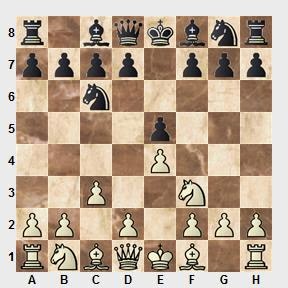Actually, I was fairly happy that Domagoj went for a line that I quite like. He gambitted a pawn and after a while seemed to get little, if any compensation for it. The opening was a Ponziani, and for those of you that haven't got the foggiest idea what I'm talking about, the game started 1.e4 e5 2.Nf3 Nc6 3.c3.
At this point there are 2 main moves, 3..Nf6 and 3..d5 and I've had to face both of these about the same amount. However, the types of positions are very different, with the knight move being more appealing to me, and less sharp generally. Domagoj chose 3..d5 and I responded 4.Qa4
When white plays 3.c3 there are 2 ideas. One is to play d4 and build a centre, the other is to develop the queen to a4 or b3. This position will certainly favour the player who has studied it the most, as there are lots of complicated lines. That tends to be why I prefer 3..Nf6 as black. Black's immediate worry is the e5 pawn, and Domagoj chose a gambit variation which holds on to it, but loses the d5 pawn. 4..Bd7. With black's queen unable to protect d5 it's a free pawn, 5.exd5.
Domagoj now played 5..Nd4 which to be honest, this would have thrown me if I hadn't recently played a game online in this variation, so had some idea of what was going on. The continuation 6.Qd1 Nxf3+ 7.Qxf3 is pretty standard and leads to an interesting position.
White is a clear pawn ahead, but black has a little compensation. White's queen can become a target to attack, and if black can get f5 in and develop behind these pawns, he will have some exciting pawn breaks in the offing. For some reason, Domagoj didn't play the mainline with ..Bd6 and ..f5, but chose 7..Nf6. Actually, I think that white is close to being just a pawn up, and maybe 8.Bc4 is best, but I played 8.Be2 and managed to work my way slowly into a good position, only to let it slip later. I'll post both my online game and the game against Domagoj.
The tournament is beginning to take shape, with a number of rearranged games having been played. I think the safest way of looking at it is like this. IM James Morris is on 100%, I've dropped half a point, Domagoj and Rebecca Strickland have dropped 1.5, while the rest of the field are further behind, except Sarah Anton who has lots of games to catch up.
The Reserves tournament is also competitive, and sometimes the results don't always reflect that. Max Phillips is leading the tournament though he has struggled in some of his games, and games will often swing to and fro between the players in this event. Saying that, if basic blunders can be made at World Championship level, such as the mutual blindness in game 6, then we really shouldn't be too hard on anybody.











